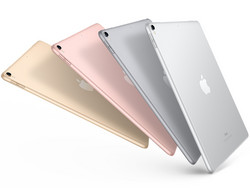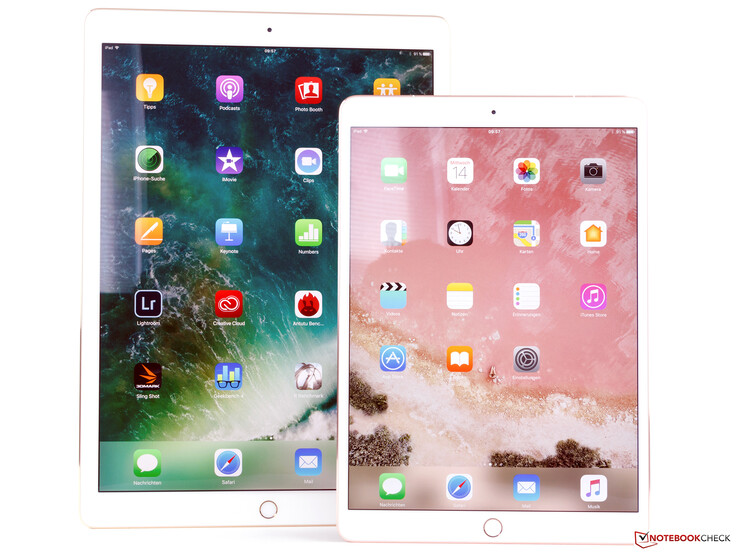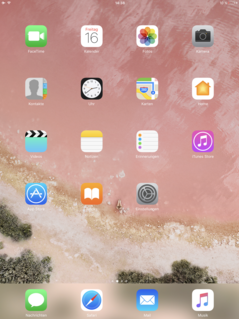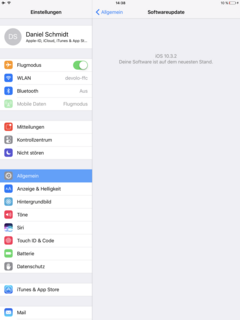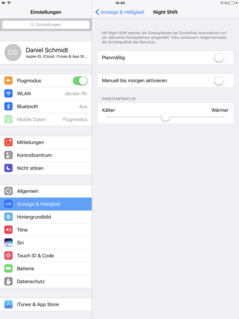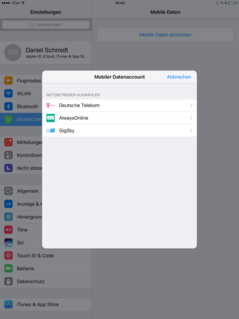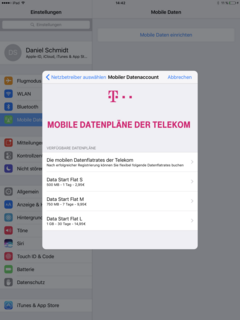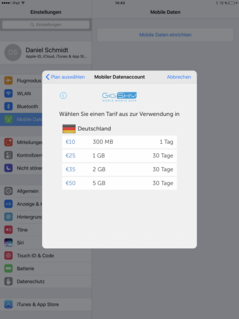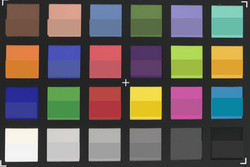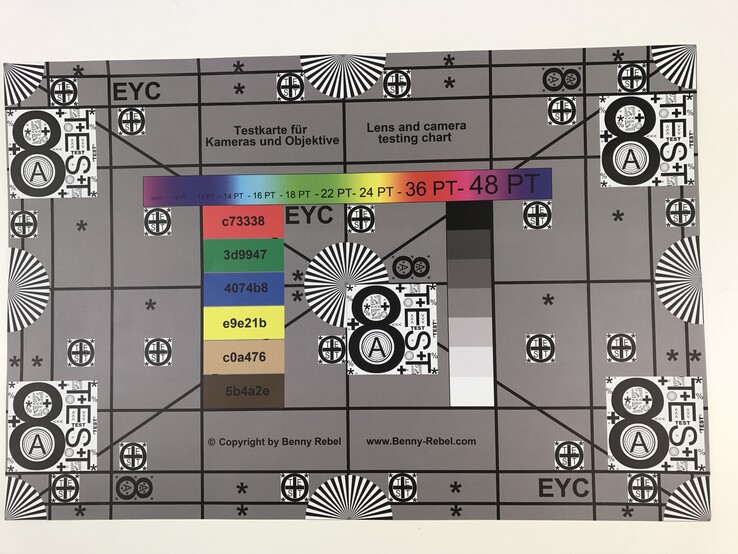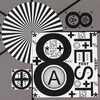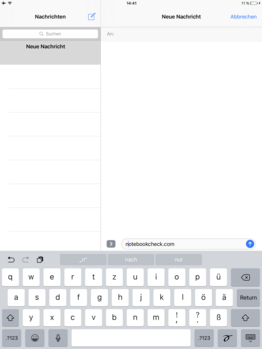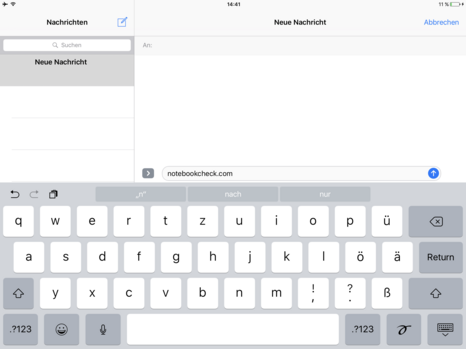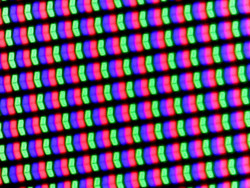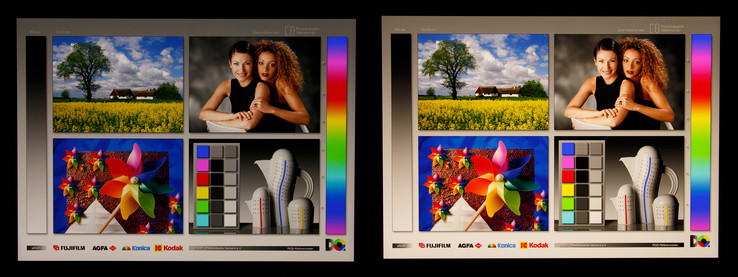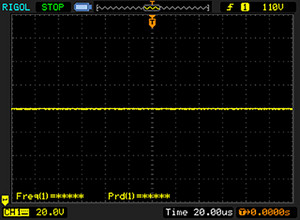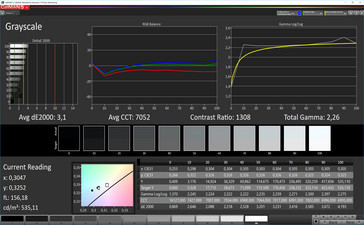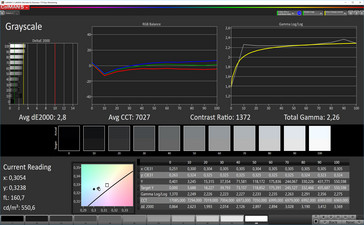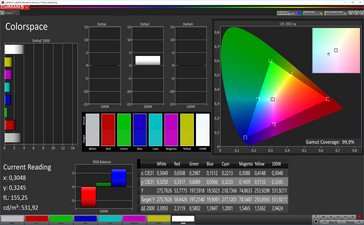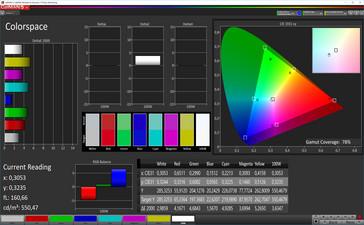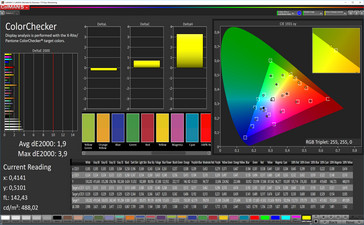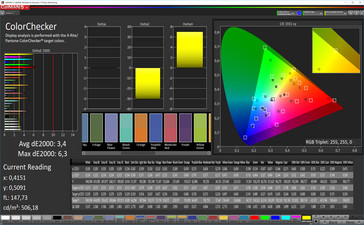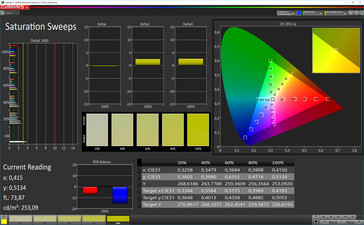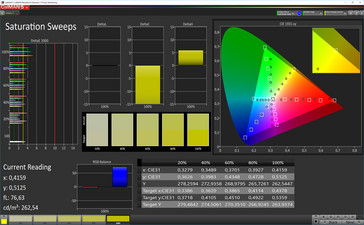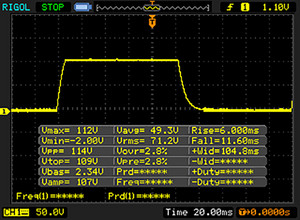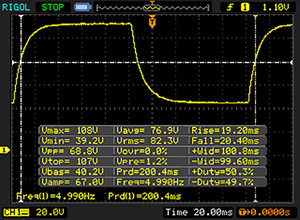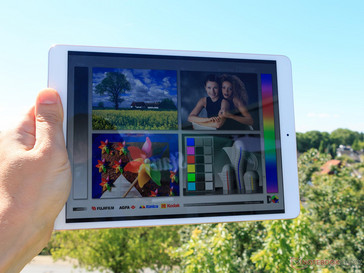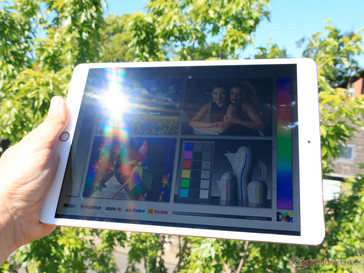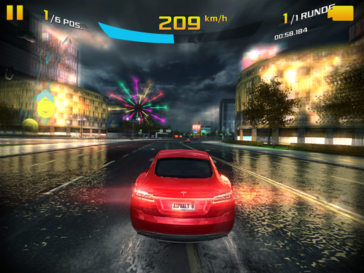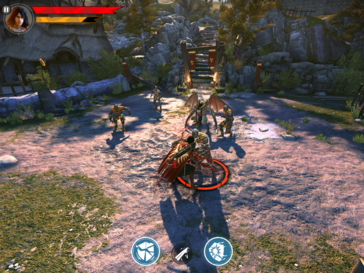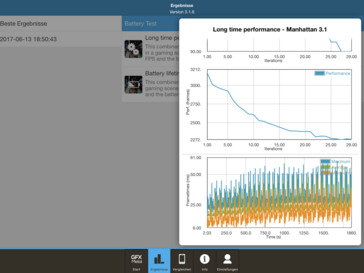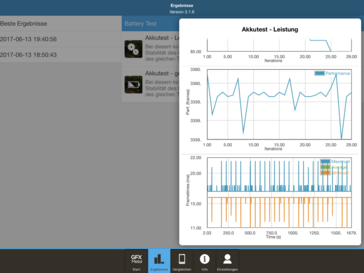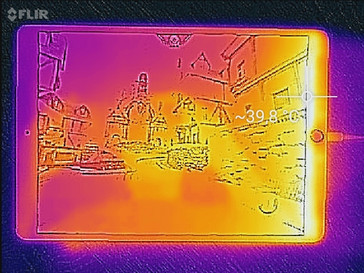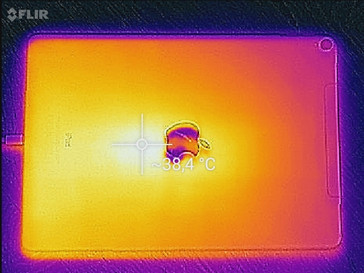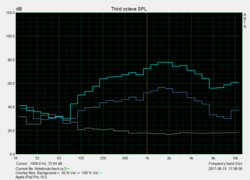Apple iPad Pro 10.5 Tablet Review
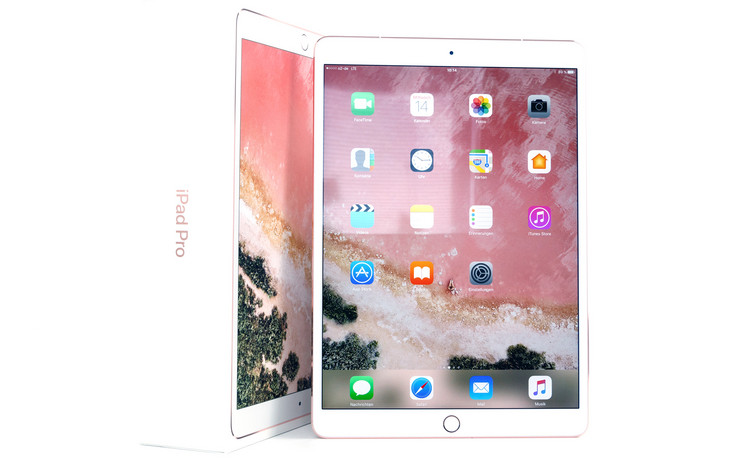
For the original German review, please click here.
The launch of the new Apple iPad Pro 10.5 has coincided with the manufacturer taking its predecessor, the iPad Pro 9.7, out of their portfolio. The new model is powered by the Apple A10X Fusion SoC and has a whole 4 GB of RAM. The display has grown slightly, supports HDR and it has a refresh rate of 120 Hz. It is also supposed to have P3 color-space coverage.
The iPad Pro 10.5 has gone up to $649 (starting price; iPad Pro 9.7 available from $605), but it has also doubled its storage capacity. There are three storage configurations available: 64, 256 and 512 GB. The 9.7 iPad went up to 256 GB only and that model was more expensive than the current equivalent. The 256 GB of storage bumps up the price of the iPad Pro 10.5 by $100, the 512 GB version costs another $200 more. If you want to use LTE as well, that will cost you another $130. This option was a little cheaper for the iPad Pro 9.7. The model with the highest configuration is available for a total of $1079.
Once again, Apple would like to claim that their iPad Pro can be used as a fully functioning notebook replacement. iOS 11, which will not be available until fall, is supposed to offer many new software features and better multitasking, which will bring the iPad closer to laptop-like performance. It also supports Apple Pencil.
High-end tablets are rare and are often based on an x86 architecture with Windows 10. For our comparison with the iPad Pro 10.5, however, we have chosen to only include tablets that are also based on an ARM operating system. These include the Samsung Galaxy Tab S3, Lenovo Yoga Book and the Google Pixel C. We have also included some cheaper devices such as the Huawei MediaPad T2 10.0 Pro and the Asus ZenPad 3s 10 LTE.
Case
From the outside, the Apple iPad Pro 10.5 does not seem to have changed a lot since its predecessor. The design is identical and impresses with its simple elegance and good workmanship. Due to the larger display, the tablet is a little bigger, but it is just as slim as the iPad Pro 9.7 (6.1 mm/~0.24 inches). Our measurements confirm this. Only the camera on the back stands out another 1.5 millimeters (~0.06 inches). If you already own the previous model, you will notice that the bezels around the display are clearly narrower.
The workmanship is of very high quality. The gaps are small and even, the unibody aluminum case is only interrupted on the LTE model, where it has gaps for the antennas on the back. The nano-SIM slot is flush with the case and, at least on our Rose Gold case, it has the exact same color as the rest of the tablet. The tray is also made completely of aluminum.
The iPad Pro 10.5 silently accepted attempts to warp the case but did twist rather easily, probably because of its flat design. Hard pressure on the back can cause waves on the display. The power and volume buttons have short travel and clear pressure points, so they react well to inputs. The iPad's battery is not removable and storage cannot be extended.
Connectivity
The Apple iPad Pro 10.5's connectivity is very similar to that of the iPad Pro 9.7. It still has a lightning port that supports HDMI and card readers via a USB adapter. The Apple Pencil can be used for input but has to be purchased separately. The three-pin Smart Connector is included and can be used for communication and power supply of peripheral devices - for example the optional Smart Keyboard.
NFC continues to be available for Apple Pay only, but this restriction should be loosened soon and the APIs will be made available to developers. The iPad Pro also has Bluetooth 4.2 and - unlike the iPhone 7 (Plus) still has a 3.5 mm audio jack to connect your headphones to.
Software
At the time of testing, the Apple iPad Pro 10.5 is running on the current iOS 10.3. We already gave a detailed review of this operating system in our review of the iPhone 7.
The future update to iOS 11 in fall 2017 is supposed to bring many improvements, such as better multitasking, a completely revised file manager and more possibilities for the Apple Pencil. It will then be possible to make notes directly onto the lock screen, like you can already on the Galaxy Tab S3. Augmented Reality will apparently also play a big part of the new OS.
Communication and GPS
Our test unit is equipped with an LTE module. It supports the Cat. 9 standard and has a maximum download speed of 450 MBit/s (upload: max. 50 MBit/s). The range of frequencies means that the device should be able to find a connection anywhere in the world. There is no dual-SIM version available, but similar to its predecessor, the Apple SIM can be used optionally. This way, an optional rate can be added in every country that Apple has cooperation partners in.
The tablet also has an included WLAN module that supports all usual IEEE 802.11 standards (a/b/g/n/ac) and can use both the 2.4 and the 5.0 GHz networks. The transfer rates to our reference router Linksys EA8500 are very good and the iPad Pro 10.5 has fast and consistent data transfer rates both when sending and receiving data, although it cannot quite compete with the Galaxy Tab S3. It has a very good range and even at 10 meters (~11 yards) distance to the router, the latencies while loading a page are only marginally lower. HD content can still be streamed without any problems.
| Networking | |
| iperf3 transmit AX12 | |
| Samsung Galaxy Tab S3 SM-T825 | |
| Apple iPad Pro 10.5 2017 | |
| Huawei MediaPad T3 10 | |
| Asus ZenPad 3S 10 Z500KL | |
| iperf3 receive AX12 | |
| Samsung Galaxy Tab S3 SM-T825 | |
| Apple iPad Pro 10.5 2017 | |
| Huawei MediaPad T3 10 | |
| Asus ZenPad 3S 10 Z500KL | |
The GPS module supports the satellite navigation systems GPS and Glonass for positioning, but unfortunately not the European Galileo. Satfix is very quick outdoors and even in buildings the Maps application found our position quickly, even in flight mode.
We will update with a comparison to the Garmin Edge 500 shortly.
Cameras
The Apple iPad Pro 10.5 has identical cameras to the iPhone 7, so we will not go into too much detail about the camera specifications. Please go to the iPhone review for more information about the camera.
The front camera of the iPad has a resolution of 7 MP (3088x2320 pixels) and offers facial and body recognition as well as Auto HDR and Full HD (1920x1080 pixels) video-recording. In good lighting the camera takes decent pictures, but the quality decreases in bad lighting.
The main, back camera has 12 MP (f/1.8) and an optical image stabilizer. It records videos in Ultra HD (max. 30 fps), Full HD (max. 60 fps) or 720p (max. 240 fps). This camera has identical features to the one on the iPhone. The recordings are very good, sharp and they have a comparatively high dynamic range. Sensors in current high-end smartphones such as the Samsung Galaxy S8+ or the HTC U11 are even better, but currently you will not find a better camera in a tablet.
We took a closer look at the Apple iPad Pro 10.5's camera in controlled lighting conditions. There was no post-processing of the pictures. We used the ColorChecker Passport to compare the colors and the test confirmed the identical performance of both the iPad's and the iPhone 7's cameras. The colors appear natural, but they all have slightly increased saturation. The white balance is rather warm. Apple has corrected the only criticism we had, which was that yellows appeared too pale.
The iPad Pro 10.5 also does well in the test chart, with identical results to the iPhone 7.
Accessories and warranty
The Apple iPad Pro 10.5 comes with a cable for charging and transferring data (lightning USB Type-A; 100 cm/39 inches long), a modular power supply with a rated output of 12.48 Watts (5.2 Volt, 2.4 Ampere) as well as a small tool to open the SIM-card slot. The device also comes with the usual information regarding warranty, a description of button and connector functions and two Apple stickers.
It only has 12 months warranty, but you can buy an Apple Care+ package for an additional $99. This gives you telephone support for two years and warranty for unintentional damages. You can have your device repaired twice in those two years but have to pay an additional service fee of $ 49 plus applicable tax for each repair. Please see our Guarantees, Return policies and Warranties FAQ for country-specific information.
Apple has a lot of accessories available in its store. The Pencil comes at the price of $99, the Smart Keyboard costs $159 - again slightly more than the predecessor's.
Input Devices and Handling
As usual, inputs are given via the capacitive touchscreen, which is very nice to use. Fingers glide well and it registers touch quickly and precisely. Despite a fat-resistant coating, fingerprints are very visible, but cleaning the screen should be easier.
The enlarged display is better suited to using the Apple Pencil and reacts precisely to its inputs. If you want to work with the tablet a lot, particularly for creative use, we would suggest you take a look at the larger iPad Pro 12.9 (2017).
The keyboard layout allows for fast and reliable typing. The fingerprint scanner is integrated into the Home button and unlocks the device quickly and reliably. The device still uses a mechanical button rather than the touch-sensitive surface of the iPhone 7.
Display
Apple has stayed true to its display philosophy and has kept the 4:3 format and a pixel density of 265 PPI. The increased size of 10.5-inches also means an increased resolution. For the iPad Pro 10.5 this converts into 1114x1668 pixels. The display also supports HDR content and has a refresh rate of up to 120 Hz. This means smoother display of video games as well as movies.
The display's brightness level is a little higher than that of its predecessor and reaches up to 665 cd/m² when the ambient light sensor is on. If the sensor is turned off, the tablet reaches 536 cd/m² in the center of the display. That is around 100 cd/m² less. In a more realistic measurement test with even distribution of light and dark areas (APL50), the iPad Pro 10.5 shows the same results. The black value has been improved and the display has a contrast of 1626:1.
We noticed no clouding on the IPS screen and Apple still manages without PWM for brightness regulation. The display is equipped with the True Tone feature which regulates color temperature depending on ambient light. This means colors are usually displayed a little warmer than usual and is particularly pleasant in dark surroundings. You can also filter blue light with the Night Shift function. This can be done either manually or by setting a time.
| |||||||||||||||||||||||||
Brightness Distribution: 87 %
Center on Battery: 634 cd/m²
Contrast: 1626:1 (Black: 0.39 cd/m²)
ΔE ColorChecker Calman: 1.9 | ∀{0.5-29.43 Ø4.78}
ΔE Greyscale Calman: 2.8 | ∀{0.09-98 Ø5}
Gamma: 2.26
CCT: 7027 K
| Apple iPad Pro 10.5 2017 IPS, 2224x1668, 10.5" | Apple iPad Pro 9.7 IPS, 2048x1536, 9.7" | Apple iPad (2017) IPS, 2048x1536, 9.7" | Samsung Galaxy Tab S3 SM-T825 Super AMOLED, 2048x1526, 9.7" | Huawei MediaPad T3 10 IPS, 1280x800, 9.6" | Asus ZenPad 3S 10 Z500KL IPS, 2048x1536, 9.7" | Lenovo Yoga Book Android YB1-X90F IPS, 1920x1080, 10.1" | |
|---|---|---|---|---|---|---|---|
| Screen | 5% | -2% | -0% | -55% | -43% | -57% | |
| Brightness middle (cd/m²) | 634 | 523 -18% | 514 -19% | 452 -29% | 410 -35% | 486 -23% | 449 -29% |
| Brightness (cd/m²) | 625 | 500 -20% | 485 -22% | 468 -25% | 409 -35% | 457 -27% | 421 -33% |
| Brightness Distribution (%) | 87 | 93 7% | 88 1% | 82 -6% | 92 6% | 88 1% | 86 -1% |
| Black Level * (cd/m²) | 0.39 | 0.52 -33% | 0.46 -18% | 0.32 18% | 0.25 36% | 0.32 18% | |
| Contrast (:1) | 1626 | 1006 -38% | 1117 -31% | 1281 -21% | 1944 20% | 1403 -14% | |
| Colorchecker dE 2000 * | 1.9 | 1.1 42% | 1.4 26% | 1.8 5% | 4.5 -137% | 5.2 -174% | 4.7 -147% |
| Colorchecker dE 2000 max. * | 3.9 | 1.9 51% | 2.9 26% | 4 -3% | 14.2 -264% | 9 -131% | 11.1 -185% |
| Greyscale dE 2000 * | 2.8 | 1.4 50% | 2.1 25% | 1.2 57% | 2 29% | 4.1 -46% | 4.5 -61% |
| Gamma | 2.26 97% | 2.11 104% | 2.22 99% | 2.11 104% | 2.17 101% | 2.73 81% | 2.22 99% |
| CCT | 7027 93% | 6662 98% | 6647 98% | 6500 100% | 6930 94% | 6579 99% | 7122 91% |
| Color Space (Percent of AdobeRGB 1998) (%) | 62.97 | 82.32 | |||||
| Color Space (Percent of sRGB) (%) | 99.55 | 99.06 |
* ... smaller is better
Screen Flickering / PWM (Pulse-Width Modulation)
| Screen flickering / PWM not detected | |||
In comparison: 53 % of all tested devices do not use PWM to dim the display. If PWM was detected, an average of 8111 (minimum: 5 - maximum: 343500) Hz was measured. | |||
We analyzed the Apple iPad Pro 10.5 display with a spectrophotometer and the software CalMAN. Apple claims that the tablet covers the larger P3 color space rather than sRGB, which was used up until now. We cannot confirm this. The display seems to fit the smaller color space exactly. It is possible that P3 is only activated in certain apps.
The iPad Pro 10.5 also does not display colors as precisely as its predecessor but still does a good job. The quality of the larger iPad Pro 12.9, however, is more like what we expected. Competitors such as the Galaxy Tab S3 also offer better color rendering. Particularly the grayscales are a little too cool on our test unit- although this should not be noticeable in day-to-day use.
Display Response Times
| ↔ Response Time Black to White | ||
|---|---|---|
| 17.6 ms ... rise ↗ and fall ↘ combined | ↗ 6 ms rise | |
| ↘ 11.6 ms fall | ||
| The screen shows good response rates in our tests, but may be too slow for competitive gamers. In comparison, all tested devices range from 0.1 (minimum) to 240 (maximum) ms. » 38 % of all devices are better. This means that the measured response time is better than the average of all tested devices (20.2 ms). | ||
| ↔ Response Time 50% Grey to 80% Grey | ||
| 39.6 ms ... rise ↗ and fall ↘ combined | ↗ 19.2 ms rise | |
| ↘ 20.4 ms fall | ||
| The screen shows slow response rates in our tests and will be unsatisfactory for gamers. In comparison, all tested devices range from 0.165 (minimum) to 636 (maximum) ms. » 59 % of all devices are better. This means that the measured response time is worse than the average of all tested devices (31.6 ms). | ||
The IPS display of the Apple iPad Pro 10.5 has stable viewing angles and is perfect for day-to-day use. Even looking at the screen from a very wide angle, the brightness is hardly diminished and reflections keep to a minimum despite its glossy surface. There is no ghosting thanks to the fully laminated display and we did not register IPS light in dark areas.
Performance
So far, the Apple A10X Fusion is the most powerful SoC from Cupertino. The 6-core CPU consists of three clusters of which one is a power-saving cluster and another is a performance cluster. They cannot run at the same time, so a maximum of three cores can be used simultaneously. The maximum clock rate is at 2.37 GHz. The device also has a co-processor M10 and 4 GB of LPDDR4 RAM running at 1600 MHz. The graphics unit probably comes from Imagination again and offers 12 cores - Apple will not give any more information on the matter.
The iPad Pro 10.5 gets good results in the benchmarks. It beats all competitors in the AnTuTu and Geekbench tests. For a better comparison, we included a smartphone with Snapdragon 835, but even this is slower in the AnTuTu (20%) and the Geekbench MultiCore (31%) tests. Looking at the Physics values from the 3DMark test gives a slightly different impression. Here, the Snapdragon is about 40 - 52% faster, probably because it can use all of its cores rather than being limited to three. The iPad's GPU performance is untouchable. It is 127% faster than the Galaxy Tab S3 (currently the fastest Android tablet) in the GFXBench 3.0. While the high resolution of the iPad shrinks this lead again if you take a look at the actual frame rates, it is still 71% faster than the Tab S3.
The performance of the Safari Mobile browser is equally excellent and makes first place in all tests. Subjectively there is nothing to criticize regarding surfing speeds or system performance. If you want to use complex content management systems in the browser, you will notice that the iPad Pro does have its limits. The pages are not displayed fully and you cannot scroll properly. If Apple really wants the iPad to become a full laptop replacement, they will need to deal with this issue.
The iPad Pro 10.5 has lost some of its memory speed. In the PassMark Mobile our 64-GB model reaches only 699 MB/s. Even the slower version of the predecessor managed 1165 MB/s with 32 GB.
| AnTuTu v6 - Total Score | |
| Apple iPad Pro 10.5 2017 | |
| HTC U11 | |
| Apple iPad Pro 9.7 | |
| Samsung Galaxy Tab S3 SM-T825 | |
| Apple iPad (2017) | |
| Lenovo Yoga Book Android YB1-X90F | |
| Asus ZenPad 3S 10 Z500KL | |
| Geekbench 4.4 | |
| 64 Bit Single-Core Score | |
| Apple iPad Pro 10.5 2017 | |
| HTC U11 | |
| Samsung Galaxy Tab S3 SM-T825 | |
| Asus ZenPad 3S 10 Z500KL | |
| 64 Bit Multi-Core Score | |
| Apple iPad Pro 10.5 2017 | |
| HTC U11 | |
| Samsung Galaxy Tab S3 SM-T825 | |
| Asus ZenPad 3S 10 Z500KL | |
| GFXBench 3.0 | |
| on screen Manhattan Onscreen OGL | |
| Apple iPad Pro 10.5 2017 | |
| Apple iPad Pro 9.7 | |
| Samsung Galaxy Tab S3 SM-T825 | |
| HTC U11 | |
| Apple iPad (2017) | |
| Lenovo Yoga Book Android YB1-X90F | |
| Asus ZenPad 3S 10 Z500KL | |
| 1920x1080 1080p Manhattan Offscreen | |
| Apple iPad Pro 10.5 2017 | |
| Apple iPad Pro 9.7 | |
| HTC U11 | |
| Samsung Galaxy Tab S3 SM-T825 | |
| Apple iPad (2017) | |
| Lenovo Yoga Book Android YB1-X90F | |
| Asus ZenPad 3S 10 Z500KL | |
| GFXBench 3.1 | |
| on screen Manhattan ES 3.1 Onscreen | |
| Apple iPad Pro 10.5 2017 | |
| Apple iPad Pro 9.7 | |
| Samsung Galaxy Tab S3 SM-T825 | |
| Apple iPad (2017) | |
| HTC U11 | |
| Lenovo Yoga Book Android YB1-X90F | |
| Asus ZenPad 3S 10 Z500KL | |
| 1920x1080 Manhattan ES 3.1 Offscreen | |
| Apple iPad Pro 10.5 2017 | |
| Apple iPad Pro 9.7 | |
| HTC U11 | |
| Samsung Galaxy Tab S3 SM-T825 | |
| Apple iPad (2017) | |
| Asus ZenPad 3S 10 Z500KL | |
| Lenovo Yoga Book Android YB1-X90F | |
| Octane V2 - Total Score | |
| Apple iPad Pro 10.5 2017 | |
| Apple iPad Pro 9.7 | |
| Apple iPad (2017) | |
| HTC U11 | |
| Samsung Galaxy Tab S3 SM-T825 | |
| Asus ZenPad 3S 10 Z500KL | |
| Lenovo Yoga Book Android YB1-X90F | |
| WebXPRT 2015 - Overall | |
| Apple iPad Pro 10.5 2017 | |
| Apple iPad Pro 9.7 | |
| Apple iPad (2017) | |
| HTC U11 | |
| Samsung Galaxy Tab S3 SM-T825 | |
| Lenovo Yoga Book Android YB1-X90F | |
| Mozilla Kraken 1.1 - Total | |
| Lenovo Yoga Book Android YB1-X90F | |
| Asus ZenPad 3S 10 Z500KL | |
| HTC U11 | |
| Samsung Galaxy Tab S3 SM-T825 | |
| Apple iPad Pro 9.7 | |
| Apple iPad (2017) | |
| Apple iPad Pro 10.5 2017 | |
| JetStream 1.1 - Total Score | |
| Apple iPad Pro 10.5 2017 | |
| Apple iPad Pro 9.7 | |
| Apple iPad (2017) | |
| HTC U11 | |
| Asus ZenPad 3S 10 Z500KL | |
| Lenovo Yoga Book Android YB1-X90F | |
| Samsung Galaxy Tab S3 SM-T825 | |
* ... smaller is better
Gaming
The Apple A10X Fusion GPU is extremely powerful and offers enough performance for games. There is no game in the app store that the Graphics Unit cannot display smoothly even with the highest details. The 120-Hz display and four speakers are great additional features for happy gaming. Playing a game is really enjoyable on the iPad Pro 10.5; particularly GPU-demanding titles such as Iron Blade come into their own here.
Emissions
Temperature
The surface temperature of the Apple iPad Pro 10.5 reaches a maximum of 37.2 °C (~98.96 °F) while idling with maximum brightness level. Under steady load the device only reaches a maximum of 40.8 °C (~105.44 °F). This is noticeable but never uncomfortable. The included power adapter, however, reaches 44.4 °C (~111.92 °F) even while idling. This temperature rises up to 51.4 °C (~126.32 °F) under load, which is quite warm.
We did the GFXBench battery test to find out how the SoC deals with the heat development under steady load. This means running each benchmark 30 times in a row and taking note of the battery level and frame rate for every run. In the easier OpenGL ES 2.0 test the iPad Pro 10.5 remains stable and at full performance. The more challenging Manhattan test (Metal-API) is a different matter. Here, the performance sunk a little more in every run and was 30% lower at the end. But even then the tablet performed 50% better than the Galaxy S8 had at the beginning of the test.
(±) The maximum temperature on the upper side is 40.8 °C / 105 F, compared to the average of 33.7 °C / 93 F, ranging from 20.7 to 53.2 °C for the class Tablet.
(+) The bottom heats up to a maximum of 35.8 °C / 96 F, compared to the average of 33.2 °C / 92 F
(±) In idle usage, the average temperature for the upper side is 32.9 °C / 91 F, compared to the device average of 30 °C / 86 F.
Speakers
The Apple iPad Pro 10.5 has four speakers. They should ensure that users always get the same sound quality, no matter how the tablet is held. Apple has not made any big changes to this concept since the predecessor. The speakers can be very loud, although the Pink Noise measurement shows that highs are too strong while lower mid-range frequencies are a little too weak. This leads to the sound not being fully balanced, although the speakers do a good job and can fill a small room with sound. Another possibility is always to connect external speakers or headphones via Bluetooth or the audio jack, which, subjectively, worked nicely.
Apple iPad Pro 10.5 2017 audio analysis
(+) | speakers can play relatively loud (84.6 dB)
Bass 100 - 315 Hz
(±) | reduced bass - on average 10.4% lower than median
(±) | linearity of bass is average (12.3% delta to prev. frequency)
Mids 400 - 2000 Hz
(±) | higher mids - on average 5.8% higher than median
(+) | mids are linear (4.3% delta to prev. frequency)
Highs 2 - 16 kHz
(±) | higher highs - on average 6.6% higher than median
(±) | linearity of highs is average (7% delta to prev. frequency)
Overall 100 - 16.000 Hz
(±) | linearity of overall sound is average (16.1% difference to median)
Compared to same class
» 37% of all tested devices in this class were better, 6% similar, 56% worse
» The best had a delta of 7%, average was 20%, worst was 129%
Compared to all devices tested
» 25% of all tested devices were better, 5% similar, 70% worse
» The best had a delta of 4%, average was 24%, worst was 134%
Samsung Galaxy Tab S3 SM-T825 audio analysis
(+) | speakers can play relatively loud (86.5 dB)
Bass 100 - 315 Hz
(-) | nearly no bass - on average 26.5% lower than median
(±) | linearity of bass is average (14.5% delta to prev. frequency)
Mids 400 - 2000 Hz
(±) | higher mids - on average 5.1% higher than median
(+) | mids are linear (5.2% delta to prev. frequency)
Highs 2 - 16 kHz
(+) | balanced highs - only 1.9% away from median
(+) | highs are linear (5.6% delta to prev. frequency)
Overall 100 - 16.000 Hz
(±) | linearity of overall sound is average (17.9% difference to median)
Compared to same class
» 46% of all tested devices in this class were better, 6% similar, 48% worse
» The best had a delta of 7%, average was 20%, worst was 129%
Compared to all devices tested
» 36% of all tested devices were better, 8% similar, 56% worse
» The best had a delta of 4%, average was 24%, worst was 134%
Asus ZenPad 3S 10 Z500KL audio analysis
(+) | speakers can play relatively loud (85.9 dB)
Bass 100 - 315 Hz
(-) | nearly no bass - on average 22.6% lower than median
(±) | linearity of bass is average (13.5% delta to prev. frequency)
Mids 400 - 2000 Hz
(+) | balanced mids - only 4.7% away from median
(+) | mids are linear (4.3% delta to prev. frequency)
Highs 2 - 16 kHz
(±) | higher highs - on average 5.5% higher than median
(+) | highs are linear (5.9% delta to prev. frequency)
Overall 100 - 16.000 Hz
(±) | linearity of overall sound is average (20% difference to median)
Compared to same class
» 56% of all tested devices in this class were better, 8% similar, 36% worse
» The best had a delta of 7%, average was 20%, worst was 129%
Compared to all devices tested
» 50% of all tested devices were better, 8% similar, 42% worse
» The best had a delta of 4%, average was 24%, worst was 134%
Frequency diagram in comparison (checkboxes above can be turned on/off)
Energy Management
Power Consumption
Despite the more powerful SoC and brighter display, Apple has managed to improve power consumption rates. Although Samsung has proven that tablets can be even more economical with the Galaxy Tab S3, the iPad needs not be criticized. Even under full load, we measured a maximum power consumption of 10.68 watt.
Unfortunately, the iPad Pro 10.5 needs a long time to charge. The tablet needs over six hours to reach 100% after having discharged completely.
| Off / Standby | |
| Idle | |
| Load |
|
Key:
min: | |
| Apple iPad Pro 10.5 2017 8134 mAh | Apple iPad Pro 9.7 7306 mAh | Google Pixel C mAh | Lenovo Yoga Book Android YB1-X90F 8500 mAh | Samsung Galaxy Tab S3 SM-T825 6000 mAh | Huawei MediaPad T2 10.0 Pro 6600 mAh | |
|---|---|---|---|---|---|---|
| Power Consumption | -16% | -3% | 0% | 18% | 19% | |
| Idle Minimum * (Watt) | 1.44 | 1.71 -19% | 1.82 -26% | 2.19 -52% | 2.08 -44% | 1.58 -10% |
| Idle Average * (Watt) | 6.12 | 7.55 -23% | 4.26 30% | 4.3 30% | 3.5 43% | 4.12 33% |
| Idle Maximum * (Watt) | 6.14 | 7.62 -24% | 4.33 29% | 4.37 29% | 3.58 42% | 4.15 32% |
| Load Average * (Watt) | 8.55 | 8.39 2% | 9.82 -15% | 8.62 -1% | 6.97 18% | 6.2 27% |
| Load Maximum * (Watt) | 10.62 | 12.08 -14% | 13.99 -32% | 11.26 -6% | 7.4 30% | 9.27 13% |
* ... smaller is better
Battery Runtime
The battery capacity of the Apple iPad Pro 10.5 has increased again and this, in combination with the better power consumption, should mean longer battery runtimes. But this is not entirely true. The maximum and minimum runtimes are better than those of its predecessor, but the Wi-Fi and loop video tests (both at 150 cd/m²) both had slightly worse results, although they are still above the manufacturer's specifications. The test unit is at about the same level as its competitors. Only the MediaPad T2 and the ZenPad 3s 10 LTE have worse battery runtimes.
| Apple iPad Pro 10.5 2017 8134 mAh | Apple iPad Pro 9.7 7306 mAh | Apple iPad (2017) 8.827 mAh | Samsung Galaxy Tab S3 SM-T825 6000 mAh | Lenovo Yoga Book Android YB1-X90F 8500 mAh | Google Pixel C mAh | Huawei MediaPad T2 10.0 Pro 6600 mAh | Asus ZenPad 3S 10 Z500KL 7800 mAh | |
|---|---|---|---|---|---|---|---|---|
| Battery runtime | 2% | 8% | 21% | 2% | 15% | -16% | -16% | |
| Reader / Idle (h) | 33.9 | 30.8 -9% | 24.9 -27% | 31.7 -6% | 33.1 -2% | 34.8 3% | 20.5 -40% | |
| H.264 (h) | 10.5 | 11.8 12% | 14.1 34% | 9.2 -12% | 11.7 11% | 12.3 17% | 9.9 -6% | |
| WiFi v1.3 (h) | 11.6 | 13 12% | 12.7 9% | 12.7 9% | 10 -14% | 10.6 -9% | 6.9 -41% | 9.7 -16% |
| Load (h) | 3.3 | 3.1 -6% | 3.8 15% | 6.3 91% | 3.7 12% | 4.9 48% | 4.1 24% |
Pros
Cons
Verdict
Apple has decided not to give the iPad Pro 10.5 a full makeover and instead made real improvements where it matters most. Particularly the new display is impressive - its great reflective properties and HDR capabilities will be particularly interesting for fans of movies, TV series and gaming. Unfortunately, we could not measure the promised P3 color-space coverage, but only the smaller sRGB color space.
The tablet has high-quality communication modules but still does not support European Galileo GNSS-positioning. Apple has also tried to save on the memory, which is slower than that of its predecessor, but this is not noticeable in day-to-day use.
Many small details of the Apple iPad Pro 10.5 have been improved, and it is definitely one of the best tablets currently available.
Overall, Apple has managed to create an excellent product and set the bar for tablets very high. Its only real competitor is Samsung's Galaxy Tab S3, which, however, has an older SoC and less storage. The storage capacity has been increased, but so has the starting price: $649. The smallest model (64 GB) will be fully sufficient for most users, especially as video and audio content is often streamed nowadays. We feel that the second model with 256 GB is the best deal and is even a little cheaper than its predecessor with the same storage capacity. The 512-GB model can be recommended for users who want to have their own multimedia collection available offline or who want to use their tablet for editing videos or processing images.
The iPad Pro 10.5 has such a great performance that you might even think about using it as a complete notebook replacement. Whether it is for video-editing of UHD material or image-processing with Adobe Lightroom, the iPad Pro 10.5 works quickly and efficiently, although we feel that the Smart Keyboard is not flexible enough and only works well on hard surfaces. The Safari browser's problems with CMSs and other complex web-based applications are annoying and file management is too inflexible. Therefore, we consider the iPad Pro to be a great tablet but no replacement for a laptop.
Apple iPad Pro 10.5 2017
- 06/26/2017 v6 (old)
Daniel Schmidt




